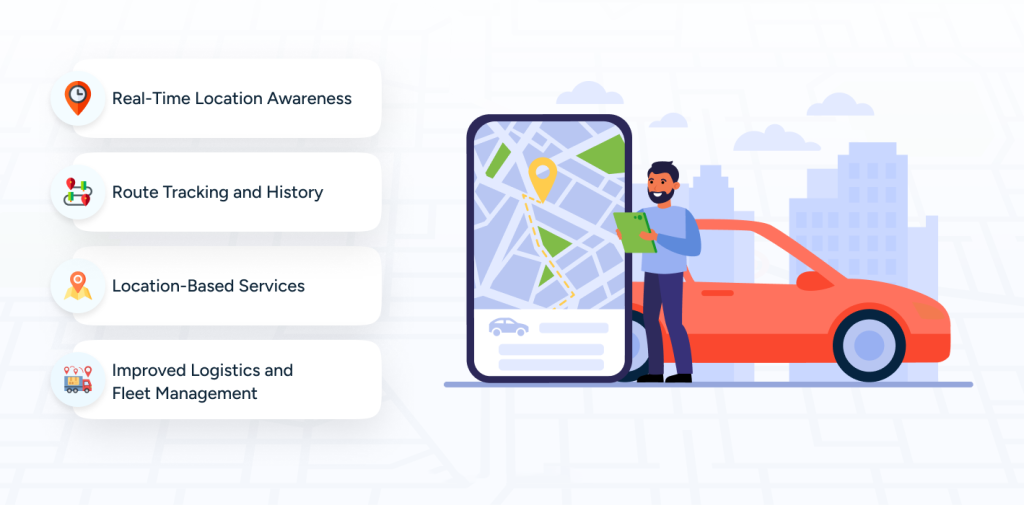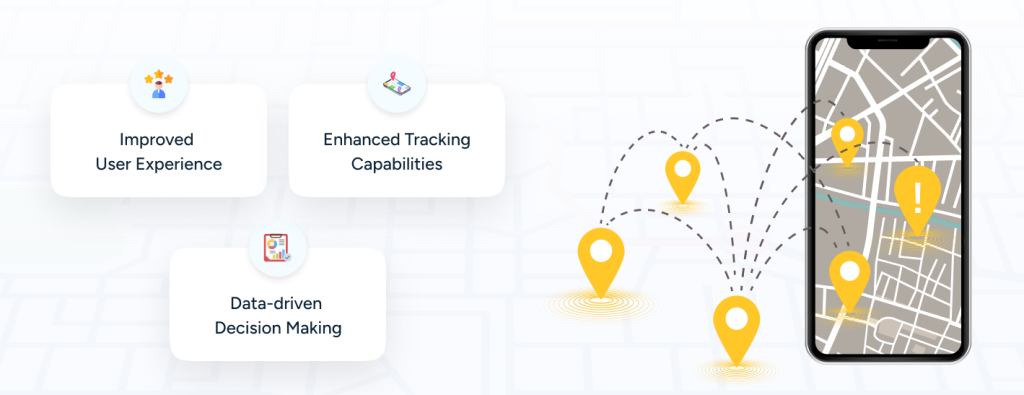The world of logistics and transportation thrives on efficiency. Real-time vehicle tracking systems have become indispensable, providing businesses with invaluable data on location, speed, and vehicle health. But what goes into building such a system? This blog takes you through the key steps involved in vehicle tracking system development, equipping you with knowledge of how these technological marvels come to life.
Understanding Real-Time Vehicle Tracking: Real-time tracking involves using GPS technology to monitor a vehicle’s location, speed, and status in real-time. It provides stakeholders with valuable insights into fleet operations, enabling them to make data-driven decisions, improve efficiency, and ensure regulation compliance. Whether it’s tracking commercial vehicles, personal cars, or assets, real-time tracking systems offer unparalleled visibility and control.
Vehicle Tracking System Development: The development of a vehicle system begins with defining the requirements and objectives of the project. Identify the target audience, desired features, and scalability requirements to design a solution that meets the specific needs of users. Leverage modern development frameworks and technologies to build a scalable, modular, and extensible system architecture that can accommodate future enhancements and integrations.
GPS Tracking Applications: Develop a user-friendly GPS tracking application that provides intuitive interfaces for users to monitor and manage their vehicles effectively. Design interactive maps, dashboards, and reports to visualize vehicle locations, routes, and performance metrics. Incorporate features such as real-time tracking, historical playback, alerts, and notifications to keep users informed and empowered.
Benefits of GPS Tracking

Fleet Management Software: Integrate fleet management capabilities into the tracking system to streamline operations and optimize resource utilization. Implement features such as vehicle scheduling, maintenance tracking, driver management, and fuel consumption monitoring to enhance fleet efficiency and reduce operating costs. Leverage analytics and reporting tools to gain actionable insights into fleet performance and trends.
Geofencing Implementation: Implement geofencing capabilities to define virtual boundaries and trigger alerts when vehicles enter or exit designated areas. Utilize geofencing for location-based services, security notifications, and operational geofence management. Customize geofence rules and actions based on specific use cases and business requirements to improve asset security and operational efficiency.
Benefits of Geofencing

Route Optimization Algorithms: Incorporate route optimization to optimize vehicle routes, minimize travel time, and reduce fuel consumption. Leverage advanced routing algorithms that consider factors such as traffic conditions, vehicle capacity, delivery schedules, and driver preferences to generate efficient routes. Continuously update and optimize routes based on real-time data to adapt to changing conditions and improve fleet productivity.
Tracking Device Integration: Integrate tracking devices with the vehicle tracking system to collect and transmit location data in real time. Choose reliable tracking devices with GPS, GSM, and other relevant technologies to ensure accurate and consistent tracking performance. Develop drivers, or SDKs, to facilitate seamless integration with different types of tracking devices and protocols.
Backend Infrastructure Development: Build a robust backend infrastructure to support the scalability, reliability, and security requirements of the tracking system. Utilize cloud computing platforms and microservice architectures to achieve scalability and resilience. Implement data storage, processing, and analysis capabilities to handle large volumes of real-time and historical tracking data efficiently.
Data Streaming and Processing: Implement data streaming and processing pipelines to ingest, process, and analyze real-time tracking data. Use technologies such as Apache Kafka, Apache Flink, or Apache Spark for real-time data ingestion, stream processing, and analytics. Apply machine learning and predictive analytics techniques to derive insights and detect anomalies in vehicle behavior.
Geospatial Data Management: Develop robust geospatial data management capabilities to store, query, and analyze geospatial data efficiently. Utilize geospatial databases such as PostgreSQL with PostGIS or MongoDB with GeoJSON support for storing and querying location data. Implement spatial indexing, clustering, and caching techniques to optimize geospatial queries and improve system performance.
Mapping APIs (Google Maps, Mapbox): Integrate mapping APIs such as Google Maps or Mapbox to visualize vehicle locations, routes, and geofences within the tracking application. Leverage mapping APIs to display custom maps, overlays, and markers based on real-time tracking data. Utilize geocoding, routing, and directions APIs to provide accurate navigation and route planning functionalities to users.
Function of Mapping APIs

Security Measures for Tracking Systems: Implement robust security measures to protect tracking systems from unauthorized access, data breaches, and cyber-attacks. Utilize encryption, authentication, and access control mechanisms to secure data transmission and storage. Implement security best practices such as HTTPS, OAuth, and JWT to safeguard sensitive information and ensure compliance with data protection regulations.
User Privacy Protection: Respect user privacy and comply with data protection regulations by implementing privacy-enhancing features and controls. Provide users with transparent privacy policies and consent mechanisms for collecting and processing their data. Minimize the collection and retention of sensitive information, and anonymize or pseudonymize tracking data wherever possible to protect user privacy.
Performance Optimization Techniques: Optimize the performance of the tracking system to ensure responsiveness, scalability, and reliability under varying workloads. Utilize caching, load balancing, and parallel processing techniques to improve system throughput and reduce latency. Conduct performance testing and optimization iterations to identify and address bottlenecks in the system architecture and resource utilization.
Application Testing and Validation: Thoroughly test the tracking application to ensure its functionality, reliability, and usability across different devices and environments. Conduct unit testing, integration testing, and end-to-end testing to validate the behavior of individual components and the system as a whole. Utilize automated testing tools and frameworks to streamline the testing process and identify defects early in the development lifecycle.
Deployment Strategies for Tracking Systems: Develop deployment strategies to deploy the tracking system across different environments, including cloud-based, on-premises, and hybrid deployments. Utilize containerization and orchestration technologies such as Docker and Kubernetes for containerized deployment and management. Implement continuous integration and continuous deployment (CI/CD) pipelines to automate the deployment process and ensure consistency across environments.
Monitoring and Maintenance Practices: Establish monitoring and maintenance practices to proactively monitor system health, performance, and security post-deployment. Implement logging, monitoring, and alerting mechanisms to detect and respond to issues in real time. Conduct regular maintenance activities such as software updates, security patches, and database backups to ensure the reliability and security of the tracking system.
Fleet Telematics Solutions: Integrate fleet telematics solutions to collect and analyze vehicle telemetry data, including engine diagnostics, fuel consumption, and driver behavior. Leverage telematics data to optimize vehicle maintenance schedules, identify fuel-efficient driving behaviors, and improve overall fleet performance. Integrate telematics data with the tracking system to provide comprehensive insights into fleet operations and performance.
Mobile App Development for Tracking: Develop mobile applications for tracking to provide users with on-the-go access to real-time vehicle information and management capabilities. Design mobile apps with intuitive user interfaces, offline support, and cross-platform compatibility to enhance the user experience and accessibility. Leverage mobile device features such as GPS, push notifications, and cameras to enable advanced tracking and management functionalities.
Benefits of Mobile App Tracking

IoT Devices for Vehicle Tracking: Explore IoT devices and sensors for vehicle tracking to enhance the accuracy, reliability, and functionality of tracking systems. Utilize IoT devices such as GPS trackers, OBD-II dongles, and telematics units to collect vehicle data in real time. Integrate IoT devices.
By following these steps and considering these additional factors, you can embark on the rewarding journey of building a robust and feature-rich real-time vehicle tracking system. This system will empower you to optimize your fleet operations, improve logistics efficiency, and gain valuable insights into your transportation network.
At Aipxperts, we understand the importance of leveraging these models to deliver high-quality software efficiently. We’re not just a development team; we’re your dedicated partner in crafting successful software solutions that meet your needs. Would you like to read more about the Taxi Booking App?
Under the Hood: Building a Real-Time Vehicle Tracking System | Hire an experienced team of Web App from Aipxperts. Contact us for project estimates and enjoy a 15-day risk-free trial period.











